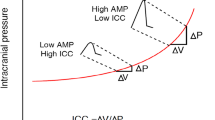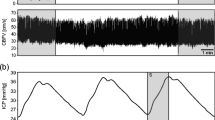Summary
The magnitude of the pulsatile intracranial pressure variations (CSF pulse pressure) is determined by the elastance of the craniospinal system and by the magnitude of the pulsatile variations in cerebral blood volume (CBV). The pulsatile change in CBV is, among other factors, determined by the compliance of the cerebral vascular bed which, in its turn, is dependent on the cerebral vasomotor tone. This concept has led the authors to devise a method for the assessment of both the elastance and the state of the cerebral vasomotor tone based on the relationship between CSF pulse pressure and intracranial pressure. This relationship was found to be of a linear nature both in clinical patients and in experimental animals. A significant, positive correlation was found between the slope of this relationship and the value of the craniospinal volume-pressure relationship: the elastance coefficient. During elevation of the intracranial pressure a breakpoint was observed in the relationship between CSF pulse pressure and the intracranial pressure above which the pulse pressure increased more rapidly. The elastance remained constant above this breakpoint. The same phenomenon was observed during plateau waves in clinical patients. Induced changes in systemic arterial pressure produced opposite effects on CSF pulse pressure and elastance coefficient. In these cases the discrepancy between pulse pressure and elastance was attributed to the pulsatile changes in CBV and this could be verified by means of electromagnetic flowmetry. The advantage of this method is that all the information is contained within the intracranial pressure signal itself, from which it can be extracted by simple means without the use of invasive tests.
Similar content being viewed by others
References
Avezaat, C. J. J., J. H. M. van Eijndhoven: Cerebrospinal fluid pulse pressure and craniospinal dynamics. A theoretical, clinical and experimental study. Thesis, Erasmus University Rotterdam. A Jongbloed en Zoon, The Hague 1984
Avezaat, C. J. J., J. H. M. van Eijndhoven, D. J. Wyper: Effects of hypercapnia and arterial hypotension and hypertension on cerebrospinal fluid pulse pressure and intracranial volume-pressure relationships. J. Neurol. Neurosurg. Psychiatry 43 (1980) 222–234
Langfitt, T. W., J. D. Weinstein, N. F. Kassel: Cerebral vasomotor paralysis produced by intracranial hypertension. Neurology 15 (1965) 622–641
Löfgren, J., C. von Essen, N. N. Zwetnow: The pressure-volume curve of the cerebrospinal fluid system in dogs. Acta Neurol. Scan. 49 (1973) 557–574
Marmarou, A., K. Shulman, J. LaMorgese: Compartmental analysis of compliance and outflow resistance of the cerebrospinal fluid system. J. Neurosurg. 43 (1975) 523–534
Miller, J. D., J. Garibi, J. D. Pickard: Induced changes of cerebrospinal fluid volume. Arch. Neurol. 28 (1973) 265–269
Risberg, J., N. Lundberg, D. H. Ingvar: Regional cerebral blood volume during acute transient rises of the intracranial pressure (plateau waves). J. Neurosurg. 31 (1969) 303–310
Author information
Authors and Affiliations
Rights and permissions
About this article
Cite this article
Avezaat, C.J.J., van Eijndhoven, J.H.M. The role of the pulsatile pressure variations in intracranial pressure monitoring. Neurosurg. Rev. 9, 113–120 (1986). https://doi.org/10.1007/BF01743061
Issue Date:
DOI: https://doi.org/10.1007/BF01743061




